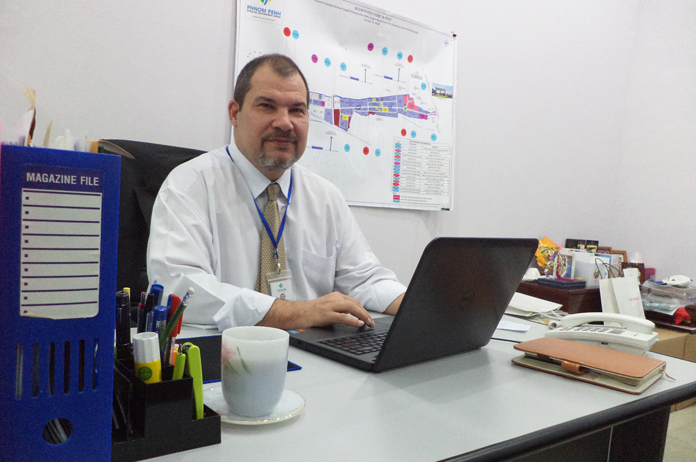Less Risk Equals More FDI, Says PPSEZ COO

Charles Esterhoy, Chief Operating Officer of Phnom Penh Special Economic Zone, says PPSEZ can relate to the Cambodian government’s current growing pains as it attempts to increasingly divert the nation's productive resources away from traditional, low-skilled manufacturing toward higher-value, and higher-skilled, semi hi-tech and precision manufacturing. To achieve this, both PPSEZ and the government are attempting to attract foreign direct investment to Cambodia—often in quite similar ways.
According to ANZ’s 2014 Global and Regional Outlook in Phnom Penh report, although clothing, textiles, and shoes still make up almost three quarters of total exports in Cambodia, the share of ‘other’ items has now risen to 19.5 percent in 2014, up from less than one percent in 2004. PPSEZ has been specifically seeking this type of ‘other’ investment since 2006 and has thus far been highly successful. PPSEZ has various semi hi-tech and precision manufacturers on site, making everything from laptop fan motors to auto parts, backlight panels for smartphones to polished diamonds. The zone will even host a Coca Cola production facility in the near future.
Esterhoy says there are currently more than 17,000 workers in PPSEZ, and last year there weren’t any work stoppages due to labor strikes across the whole zone. He genuinely believes these new industries offer the average Cambodian worker better working and living conditions, skill development, and the creation of future prospects other than employment in traditional manufacturing sectors such as garments and agriculture. Minebea, a Japanese company with manufacturing facilities around the globe, is one such resident at PPSEZ, which manufactures micro-motors and precision electronics as part of a regional manufacturing strategy. This is an example of the type of manufacturing expansion policy Cambodia is seeing more and more of, and exactly the type of FDI the Government is attempting to stimulate on a larger scale with its new industrial strategy.
These types of companies choose to move their operations to PPSEZ, and SEZs generally, for a variety of reasons. “The bottom line is,” says Esterhoy, “they are looking to limit risks of any kind while maintaining profitable operations.” SEZs provide hard infrastructure in the form of roads, utilities, and security/emergency services. Quite possibly the most important factor at an SEZ is consistent electricity supply and service; hence PPSEZ built its own power generation and backup plant on site in 2006. No higher-end manufacturer can afford power cuts, and the same often applies to water. SEZs also often provide soft infrastructure, such as onsite access to government representatives and customs services. Some also play an advocacy role, presenting investors’ opinions and concerns to local and national government bodies when necessary. “Our job here at PPSEZ is essentially preparing for the future, as a means to limit risk for our investors,” says Esterhoy, “And we must have as few risks as possible if we are to attract the highest forms of FDI.”
Therefore, Esterhoy suggests, in order to continue encouraging FDI of this kind to Cambodia as a whole, the government needs to continue to take steps to cut risks across the Cambodian economy. The number one impediment to FDI across Cambodia currently is the cost and availability of electricity, believes Esterhoy. However, the Cambodian government seems well aware of this, with a number of coal-powered and hydro-powered plants currently being developed across the country in partnership with GE. One of these plants opened at the end of last year, with more to come online later this year. What this should achieve, suggests Esterhoy, is more stable power and less reliance on Vietnamese bought power so that the cost can reduce across the board. As soon as average power costs drop, says Esterhoy, Cambodian FDI will immediately grow.
The second largest impediment to Cambodia seeing more FDI from semi-high tech producers is the stigma of corruption lingering over the country. This has been a key concern of the international community for many years, says Esterhoy. However, Esterhoy sees positive steps being taken by the government with initiatives such as the Anti-Corruption Unit, increased awareness, and new automated systems across the market.
The final impediment is Cambodia’s logistics network. Many new investors now manufacturing parts in Cambodia demand fast and efficient transport of these parts back to countries such as Thailand, Vietnam, China, Korea, or Japan (to name a few) for their final assembly and final distribution. They depend absolutely on Cambodia’s road, rail, sea, and air network, stresses Esterhoy. While positive steps are being taken across the Cambodian logistics network, including various air and sea port expansions, the spread of automated customs clearance systems, and the improvement of the southern rail line (and potential for a northern rail line in the future), these improvements need to become an immediate and countrywide focus if FDI is to increase in the near future.
In sum, Esterhoy gives his own investment prospectus: “What you hear overseas in the international press is not all true. There is a lot of positive change here, and it is set to continue at a rate previously unseen. With ASEAN placing Cambodia in a hugely strategic position, and the existence of a young, motivated, and plentiful workforce capable of learning almost anything, Cambodia is well and truly open for international business.”